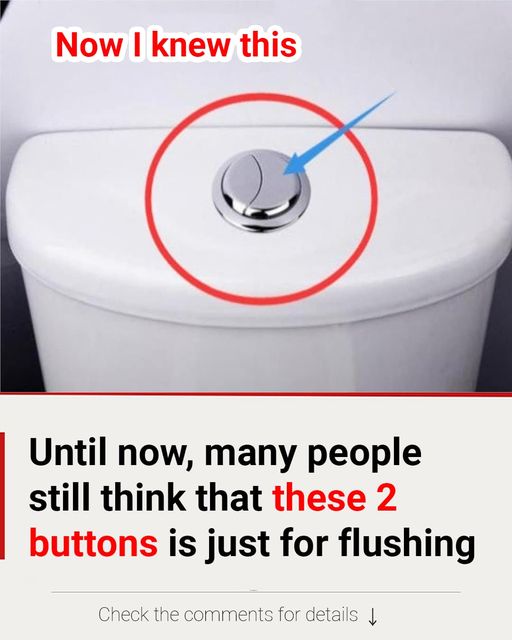If you’ve ever used a modern toilet, you may have noticed two buttons at the top. Most people assume these buttons serve the same purpose—flushing. However, there’s more to these dual flush buttons than meets the eye. Designed for efficiency and water conservation, they offer a more sustainable way of managing waste disposal. But how exactly do they work, and why are they important? Let’s break down the functionality and benefits of these buttons that many still overlook.

The Basics of Dual Flush Toilets
Dual flush toilets are equipped with two buttons, each designed to release a different amount of water based on the type of waste being flushed. The larger button is meant for solid waste, releasing around 6-9 liters of water. This ensures that heavier waste is effectively flushed out. The smaller button, on the other hand, releases about 3-4.5 liters of water, making it ideal for liquid waste, which requires less water to clear.
The idea behind dual flush systems is simple: use only the necessary amount of water, reducing overall consumption. By pressing the right button for the type of waste, you contribute to a significant reduction in water usage. This eco-friendly system not only benefits the environment but can also help save money on your water bill over time.
Water Savings with Dual Flush Systems
One of the most significant advantages of dual flush toilets is the amount of water they can save. Traditional single-flush toilets use a standard amount of water—usually around 9-12 liters—regardless of whether the waste is solid or liquid. This means that every flush uses more water than necessary, resulting in considerable water waste.
In contrast, dual flush toilets are designed to minimize waste by using only the amount of water needed for each type of flush. By simply pressing the appropriate button, households can save up to 20,000 liters of water annually compared to traditional single-flush toilets. This impressive water conservation is especially valuable in areas prone to drought or water shortages.
The Environmental and Financial Impact
While installing a dual flush toilet may initially be more expensive than a single-flush model, the long-term benefits far outweigh the upfront costs. Not only does it help conserve water, but it also lowers utility bills. The less water used, the lower the water bill, making dual flush systems an investment that pays off over time.
In addition to saving water and money, dual flush toilets contribute to a more sustainable lifestyle. Water conservation is crucial in reducing the strain on local water sources, sewage systems, and wastewater treatment facilities. By using a toilet that limits water use, individuals can actively participate in global efforts to preserve water resources.
The Origins of the Dual Flush System
The concept of dual flush toilets isn’t new. It was introduced by Victor Papanek, an industrial designer, in 1976. Papanek’s idea focused on reducing water consumption by offering two flushing options, an innovative approach that was ahead of its time. The concept was first put into practice in Australia in 1980, where water scarcity was becoming a pressing issue. Since then, dual flush toilets have been widely adopted across the world as awareness about water conservation has grown.
Australia’s adoption of dual flush toilets is particularly notable because it marked the beginning of a global shift toward more water-efficient bathroom fixtures. Other countries soon followed suit, especially those facing water shortages. Today, many new homes and commercial buildings are equipped with dual flush toilets as part of sustainable construction practices.
Why Many People Are Still Confused
Despite the advantages of dual flush toilets, many people are still unaware of how they work. The confusion often comes from a lack of clear instructions or awareness about the benefits of using the appropriate button. As a result, some users press the larger button out of habit, assuming it’s the “regular” flush, while the smaller button is rarely used. This misunderstanding diminishes the water-saving potential of dual flush toilets.
For dual flush systems to be truly effective, it’s essential to educate users on how they work and why selecting the correct button matters. Simple steps like adding labels near the flush buttons or including educational materials in homes and public restrooms can make a difference. Awareness campaigns can further promote the environmental and financial benefits of dual flush toilets, encouraging more people to use them properly.
Conclusion: Making the Most of Dual Flush Toilets
Dual flush toilets offer a simple yet effective solution for reducing water consumption and promoting sustainability. By understanding how these toilets work and using the correct button for each type of flush, households can save thousands of liters of water each year. While the initial installation may come with a higher price tag, the long-term benefits to both the environment and your water bill make it a worthwhile investment.
As awareness grows and more people adopt water-saving habits, the dual flush system stands as an example of how small changes in daily routines can have a significant impact. So, the next time you see two buttons on a toilet, remember that they’re not just for flushing—they’re for conserving water and making a difference, one flush at a time.





